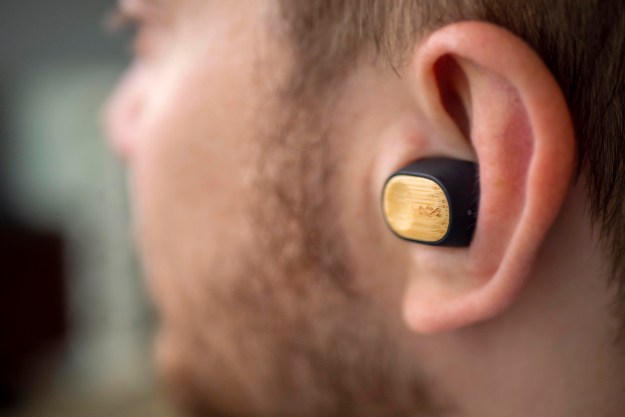
“The Liberate Air are the most environmentally friendly true wireless headphones you can buy, but they’re not perfect.”
- Great battery life
- Clever employment of sustainable materials
- Sweat resistant
- Beautiful to look at
- Hit-or-miss touch controls
- Too large for smaller ears
- Bold, bass-forward sound
If you’re looking to limit your environmental impact but still want the convenience that comes from using the latest and greatest wireless technology, there are very few manufacturers to turn to.
With a mission statement that includes building its devices as sustainably as possible, House of Marley — the Rasta-themed brand that’s actually owned by Bob Marley’s family – is one of the coolest new audio brands in the space. From turntables to headphones, HOM makes an assortment of quality audio gear with recycled materials and sustainable bamboo, all while remaining competitively priced.
We like the Liberate Air’s materials, their massive battery, and their gorgeous bamboo-lined case. But, as the company’s first crack at fully wireless earbuds, they’re still a few steps away from primetime.
Features and design
The Liberate Air arrive in a pill-shaped case lined on the outside with black recycled fabric and silicone. Open its treasure-chest lid and you’ll find the sleek, bamboo-coated headphones safely nestled in molded charging pods amid a bed of bamboo that runs the length of the case. The bright wood pops against the dark background for a striking look inside the case.

The earbuds are carved into pill-shaped pods largely made of recycled plastic and silicone. Fit is a bit snug for smaller ears, and one colleague actually couldn’t get the buds to stay in. The company does include three sizes of silicone eartips, though, so most people should able to find a good seal.
One reason the headphones look so great is that there are no buttons. Instead, HOM employs small touch sensors between indented sections on the outside of each earbud which allow you to play and pause music or switch songs.
Due to issues that often come about when adjusting earbuds or sweating in the gym, we’re not huge fans of touch controls in general, and these, unfortunately, are pretty inconsistent. Basically, the touch controls won’t work unless struck perfectly in the middle. Once you get the hang of touching them exactly in the center, it becomes less of a problem, but it did give the headphones a real learning curve.

On the other hand, the Liberate Air offer excellent battery life, sporting nine hours of juice, which is nearly double the 5 hours offered by AirPods for $10 less, and they have an equally impressive 32 hours of charging in the case. That’s a full work week of listening time without plugging in the included USB-C cable, which is fantastic at any price.
The Liberate Air also have another feature AirPods don’t: Water resistance. They’re rated IPX4 sweat resistant, which means you won’t have to worry about them in the gym. The silicone exterior also helps them stay very secure in your ears; we took them on multiple long runs and lifting sessions, and never had so much as a wiggle.
Pairing is quick and easy, thanks to the headphones’ Bluetooth 5.0 chip. Just open the case, pull them out, and pair one of them with your phone, tablet, or other device. From there, you can listen with both headphones, or remove one and put it back in the case to listen to a single bud at once — good for commuters who want to hear what’s going on around them.

We do wish the Liberate Air had some way to pipe in sound from the outside world, but that’s not a huge omission at their $150 price tag. It’s a nice feature to have and would keep both headphones in our ears more often when running around town.
One issue with the Liberate Air from a sustainably standpoint is that House of Marley doesn’t offer a battery replacement service, which means they will only last for a few years of dedicated use before you’ll likely need to toss them.
This is true of the vast majority of true
Sound and call quality
The first thing you’ll notice about the sound that comes from the Liberate Air’s 5.6mm dynamic drivers is the bass. They set the low-end of your favorite tracks free, bringing a bold and rumbly punch that fits perfectly with their namesakes’ music.
Unfortunately, the prowess down low isn’t matched in the upper midrange or high-end of the headphones, with acoustic guitars, female vocals, and snare drums tending to lack definition.

We noted less clarity than we’d like on tracks with big, lush, arrangements, like older Beatles or Beach Boys cuts, but there is still a noticeable lack of shimmer when listening to more modern cuts from Kendrick Lamar and others. This seems mostly due to how bold the bass is overall. The headphones don’t sound awful; they’re just not nearly as clear as
That said, as a pair of workout headphones, the sound quality is more than adequate. After all, how intensely are you focusing on the brightness of guitar strings when you’re breaking a sweat? The big bass should also help propel you through your workout.
Call quality through the tiny pin-prick mics on the outside of each earbud is surprisingly decent, with no criticisms that wouldn’t be leveled at the majority of bluetooth headsets. Voices are just never going to come through as clear as when there is a microphone directly in front of your mouth like when you have a handset to your ear, but these did the job.
Warranty information
House of Marley covers materials and workmanship for two years from the date of purchase.
Our Take
The House of Marley Liberate Air are a beautiful pair of sustainably-made true
Is there a better alternative?
Yes. If you’re looking for a great pair of true
If you’re looking for something that’s easier on the environment, Samsung’s Galaxy Buds have been rated as among the easiest to replace the battery, which should make them last longer than most competitors.
How long will it last?
Like all true wireless models, we expect the House of Marley Liberate Air will last at least two years of solid use. After that, listeners might see diminished battery life as the tiny lithium ion cells inside degrade over time.
Should you buy it?
No.
If you’re smitten by the sustainable materials used to make these headphones, they’re worth a look, but the fact that the battery can’t be replaced is reason to pause if environmental impact is high on your list of priorities.
If you’re looking for a fantastic pair of true




